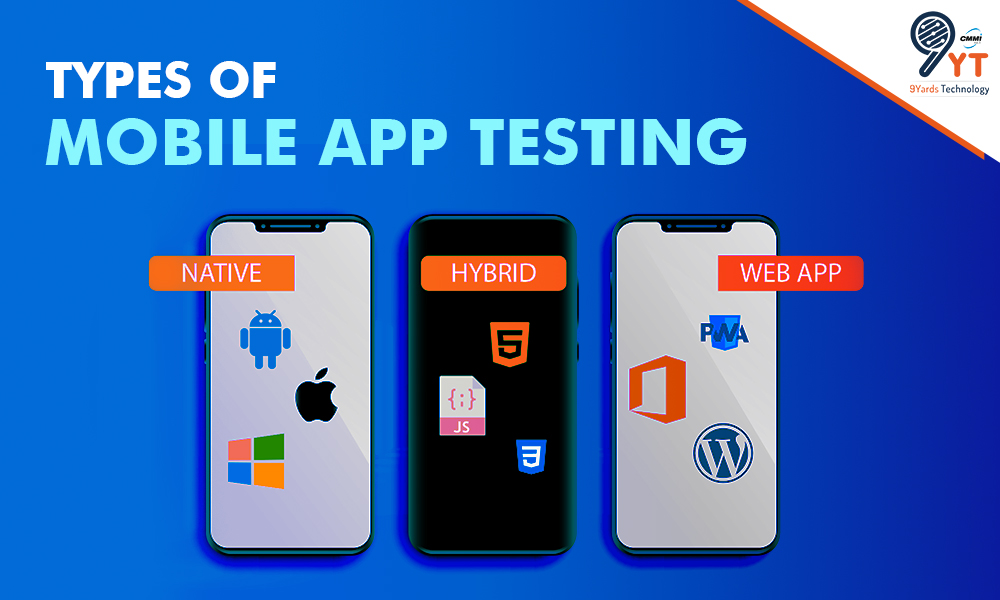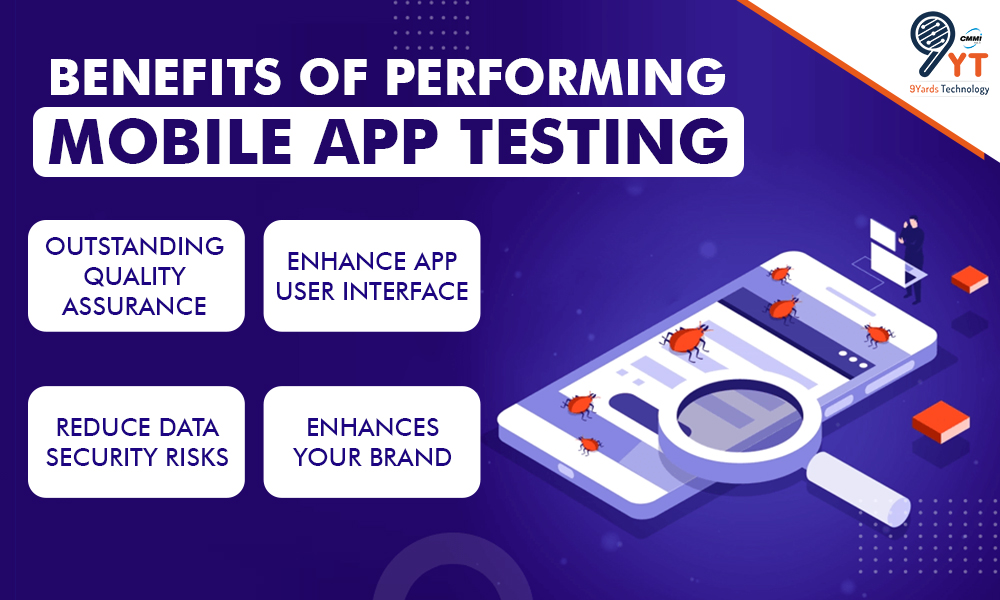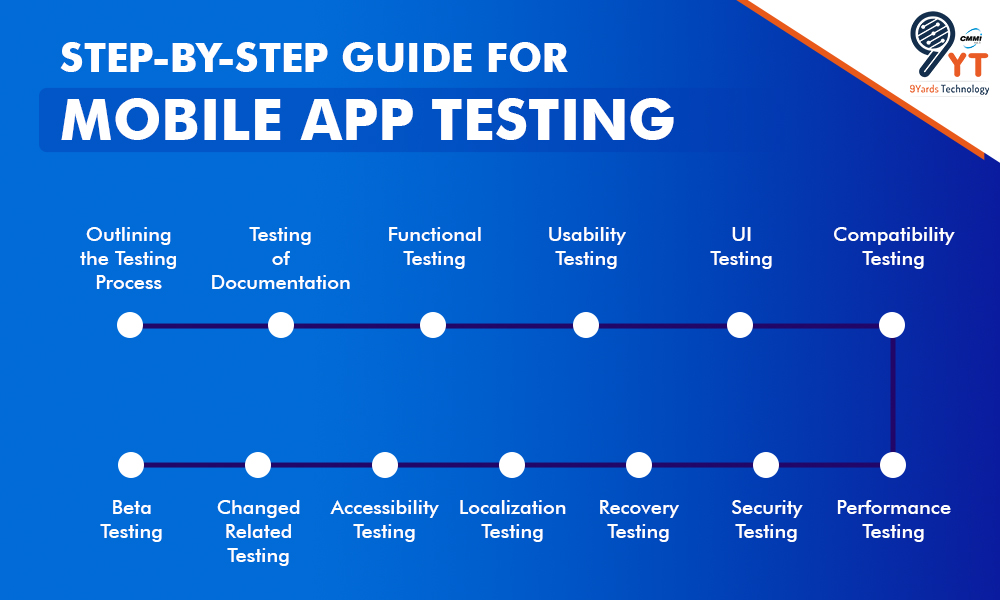
Overview
The practice of reviewing and confirming the functioning and quality of a mobile app is known as mobile app testing. In other words, you may make sure that a mobile app satisfies all technical and end-user criteria through testing before releasing it to the market (the Play Store for all Google or Android-based mobile devices, and the App Store for iOS devices). Every mobile software created for portable devices is tested for usability, stability, and usefulness.
Mobile device usage has long gone beyond simple communication and has extended to include many of the tasks we complete every day. Due to the creation of many mobile apps, this reliance on mobile devices has rapidly expanded. These applications may carry out several tasks in our everyday lives and help achieve business requirements.
Mobile applications are already being used by businesses as a crucial tool for growing their operations and connecting with their consumers. Mobile app testing is becoming an essential step in the creation of all mobile apps due to the quick growth of mobile web, hybrid, and native apps.
By 2025, 18.22 billion mobile devices are anticipated to be in use, according to Statista. The need for mobile applications has significantly increased globally as a result of the explosion of mobile devices. Another study reveals the expanding worldwide mobile app business, with $613 billion in sales anticipated by 2025.
Therefore, it’s crucial to make sure an app offers a consistent experience across all platforms and OS versions. Teams can now test apps for functionality, usability, and consistency across a variety of devices and operating systems thanks to mobile app testing.
What is Mobile App Testing?

The technique of evaluating mobile apps for usability, compatibility, functional, and consistency flaws is known as mobile application testing. Before an app is formally released, a process is required to make sure it satisfies all the standards. Performance, certification, installation, and other common sorts of testing are included in mobile app testing. It also includes elements unique to mobile devices, such as an interruption, memory leakage, and location.
Examining an app’s functional and non-functional components is a common part of testing a mobile app. Additionally, it is put to the test for consistency, usability, performance, and compatibility with many platforms and devices by highly trained experts. In 2022, there will be 255 billion mobile app downloads, highlighting the necessity of deploying highly thought-out apps to capture consumers’ attention.
Types of Mobile App Testing

Understanding mobile applications and how they differ from websites and web pages is the first step in performing mobile application testing.
Software created specifically for mobile platforms like smartphones, tablets, and wearables is known as a mobile app. Most mobile apps are downloaded via app stores or mobile marketplaces managed by the company that provides the device’s operating system, such as Apple’s App Store or Google Play Store. The following three categories of mobile applications exist:
Web Apps
Web applications are websites that may be accessed using a desktop or mobile browser. Less money may be spent on online web apps than on mobile apps. They are also simpler to construct and keep up.
Native Apps
Apps created for a single operating system are called “native” applications. Thus, native apps are accessible for Windows, iOS, and Android. This makes it impossible to utilize native Android apps on iOS, Windows, or vice versa.
Hybrid Apps
Apps that combine features of native and online applications are called hybrid apps. These applications give developers the ability to reuse code with little to no script alterations across a variety of platforms and operating systems.
Why Mobile App Testing is Crucial?
The main objective of creating mobile applications is to grow the company and connect with as many people as possible globally. What happens, though, if the user finds the generated mobile apps to be buggy and challenging to use? The likelihood of people uninstalling mobile apps is high. Any company would not want its customer to delete the mobile applications and move to their rivals because of this. Mobile app testing is essential in this situation since it provides information on the app’s functioning.
Appropriate and thorough mobile app testing is essential to ensuring that mobile apps satisfy the needs and objectives of end users. However, if the mobile applications are not tested, there is a great likelihood that bugs or mistakes will be present and may interfere with the apps’ operation. A negative user experience results in their deleting or uninstalling an app. As a result, testing mobile apps is a crucial step that should not be skipped.
Potential problems and mistakes that might affect the functioning and performance of mobile applications can be discovered when you test them. For the smooth experience of the end-users while using the app the mistakes and defects must be rectified as soon as possible.
To guarantee that mobile applications are dependable, safe, and user-friendly, it is crucial that they undergo extensive testing before being made available to end users.
Benefits of Performing Mobile App Testing

Testing mobile apps is a difficult procedure that differs greatly from testing websites or software. However, your company may benefit from a number of key advantages by using the appropriate mobile app testing technology and a thorough testing methodology, including the following:
Outstanding Quality Assurance
After the app development process is over, you shouldn’t be in a hurry to release your app onto the market. It is advised to perform some tests to make sure the program delivers essential features like execution and downloads without a hitch.
Professionals should carefully examine each element of the mobile application and evaluate how well it integrates with the current infrastructure. Before publishing it officially to the app store, you may get rid of the majority of usability difficulties by thoroughly QA testing, inspecting, and correcting bugs.
Enhance Your Revenue Generation
The mobile economy is growing. By 2023, 80.1 million people are expected to have used proximity mobile payment transactions in the US. To increase consumer involvement, many merchants are putting Android kiosks or mobile POS systems into their stores. Businesses may use this strategy to develop their income wisely and fully benefit from it.
You may foresee bugs that can adversely affect your consumers’ online shopping experience by doing a thorough mobile app test. To improve the shopping experience and get a competitive advantage over rivals, your IT staff may address these issues collaboratively. Testing mobile apps may increase a company’s device management effectiveness.
Enhance App User Interface
User experience (UX) is extremely crucial for any mobile app. App testing enables QA teams to examine the app’s appearance and feel and mimic how their target user could use it. Logical navigation and simple design are essential components of a good app user experience. Additionally, you need to test your app’s UI designs in various situations. You might be able to foresee how your users will respond to the app after it has been released by putting yourself in the end user’s position and experiencing the emotions and app triggers.
Reduce Data Security Risks
Business apps’ development costs range from $100,000 to $500,000, according to studies. Can you imagine losing your clients’ confidence due to a careless app provider causing a personal data breach? Cyber dangers have grown to be a serious issue in the world of contemporary technology. Therefore, when it comes to app testing, businesses need to pay additional attention to these delicate nuances. Preventing hazards is preferable to attempting to do so after problems do occur.
Enhances your Brand
Users frequently turn away from poor-quality and ineffective apps. Because of this, mobile app developers have to make an effort to construct a distinctive brand for their goods. Therefore, how does testing support branding? Companies should start by putting the advice from app testing into practice. You’ll notice that more people value and like using the software after implementing this. From there, word gets out to more clients. In addition, app creators should be aware that major app stores like the Apple store are tight about preventing defective programs from running on their platform.
Methods for Testing Mobile Apps
You could consider the many methods that can be used to carry out tests after learning the proper approach to mobile app testing. There are two methods for testing mobile apps: manual testing and automated testing.
Both strategies, however, have benefits and drawbacks. Consequently, mobile application testing involves the use of both strategies in conjunction.
Let’s learn more about these strategies in detail in this segment of the mobile app testing guide.
Manual Testing
The term “manual testing” refers to a test strategy that is carried out manually rather than through an automated process. For quality assurance, it needs human input to test the features and functionality. The manual testers in this instance manually carry out the test case, record the outcome, and find any potential flaws.
Manual app testing involves checking the usability and performance of the application while evaluating it from the perspective of the user. Manual testing is a risky strategy, but it shouldn’t be used since it mimics real-world situations that automated testing cannot.
When should manual testing be preferred?
- When you carry out ad hoc testing, exploratory testing, and usability testing
- When you implement UI interactivity and device compatibility
Automation Testing
In automated testing, test cases are executed using test tools with little assistance from humans. For a mobile app, you may execute as many test plans as you like, increasing test coverage. However, you should only think about automating test cases that can’t be done manually, are simple to execute, and have expected outcomes.
When is automated testing preferable?
- Regression testing, repetitious jobs, and performance testing benefit most from it.
- Use for testing a complex mobile app
Step-by-step Guide For Mobile App Testing

Step 1 – Outlining the Testing Process
Before beginning the testing of a mobile app, preliminary planning is required. The majority of QA teams outline a test plan that includes the features to be tested, objectives and techniques of the testing process, and a timeframe for when the app will be released.
Testing on actual devices is also advised because it improves accuracy. You may select a few of the most popular device models on the market and conduct tests on them to make the most of your testing efforts. Other aspects to take into account while choosing a mobile device include various screen resolutions, operating systems, RAM size, and connection.
Choosing between manual testing and automated testing would also be beneficial. Even though the majority of testers favour automated testing over manual testing, many still see both as essential. Once you have your plan in place, you can carry on with the following testing stages.
Step 2 – Testing of Documentation
The first stage of testing a mobile app is documentation testing. It is typically related to the documentation that needs to be created before or during software testing. It entails developing and analyzing app requirements. Test cases, test strategies, test scenarios, and traceability matrices are among the recorded artefacts. It’s advisable to clear up any differences now rather than waiting to begin any advancements.
Step 3 – Functional Testing
Functional testing enables you to determine whether your application meets all of your requirements and offers the necessary functionality as planned.
There are a few crucial considerations you should make while testing an app’s functioning. Your target audience is the first consideration. Is your software intended for consumers or corporate users? Is it for profit or educational purposes?
Consider business functions in the second place. This might include functions like camera or geolocation, sending and receiving messages while the program is operating in the background, resuming the app after it was halted, memory usage by the app, and battery capacity effects.
Your distribution channel should be evaluated as the third component. Publication regulations vary depending on distribution platforms, such as Google Play and the App Store. To prevent further revisions, it is therefore better to confirm that your apps meet the criteria during the functional testing phase.
Step 4 – Usability Testing
Testing your app’s usability, also known as UX testing, is a procedure that determines how user-friendly your app is. Additionally, it guarantees that users of your mobile app have a pleasant surfing experience. The efficiency, efficacy, and satisfaction of your usability testing may be used to evaluate its quality.
For improved client interaction, several businesses transform their Android devices into self-service kiosks by installing apps. You may keep an eye out for crucial indicators during the usability testing process, such as screen orientation, navigation, and visual interactions.
Including many stakeholders, while doing usability assessments on mobile apps is another recommendation. Business leaders and management staff may better comprehend the entire app development process by being involved, and giving smart suggestions before it goes to market.
Step 5 – UI Testing
Testing the user interface (UI) ensures that all of your visuals are clear and undistorted on mobile screens without any resolution problems. The goal of the graphical user interface (GUI) is to give app users a fun and engaging experience. As a result, the UI testing you do relies on the goal of your project.
Additionally, testing your program across at least three different OS platforms is advised. The resolution, screen size, colour and theme design, multi-touch or single touch, long or short press, and position are some of the key components you should experiment with.
Step 6 – Compatibility Testing
Compatibility testing ensures that the software runs smoothly on a variety of hardware configurations, screen sizes, and screen resolutions. As mobile devices vary in platforms, models, and OS versions, some of the crucial device-specific elements for compatibility testing include OS, browser, database, device, and network configurations. When doing compatibility testing, it’s essential to choose a subset of devices pertinent to your application.
Step 7 – Performance Testing
The process of determining if your application behaves or performs as intended under a certain workload is called performance testing. Load testing, stability testing, volume testing, and concurrency testing are a few of the situations that have been evaluated. Apps that are quick and responsive typically have happier users and more five-star reviews.
Step 8 – Security Testing
It would be ideal if you provided a secure environment for users of your software. Security testing examines the possibility of online dangers such as viruses, malware, illegal access, and data breaches. It aids in the verification of your application’s security features.
Make sure to test for features like fingerprint and face ID, app storage, two-factor authentication, data encryption, and personal data protection when you do security testing. Maintaining user security when they use your app is another strategy to increase brand loyalty.
Step 9 – Recovery Testing
You may find out through recovery testing if your app can quickly fix any hardware or software problems. With its assistance, you may proactively remedy any potential flaws before the official release. Network difficulties, power outages, loss of wireless connection, and unresponsive server faults are other recovery concerns to check for. This procedure enhances your app system’s strength and raises the output’s standard. Your users may relax knowing that in the event of unanticipated technological hiccups, their app data can be retrieved.
Step 10 – Localization Testing
Localization testing ensures that your software adjusts to particular audiences depending on cultural nuances if made available to consumers worldwide. According to QA teams, the program must function properly in languages other than the default language. It may also add dialects if your business wants to give mobile consumers a more tailored app experience.
Step 11 – Accessibility Testing
Testing for accessibility entails ensuring that your software complies with the law and is accessible to all users. Verify that the app doesn’t break any rules that might result in paying significant fines. The capacity to recognize voice, screen magnification, text color contrast, and dynamic font size are a few aspects that must be tested. When creating a customer-facing app, you should also place an emphasis on interactive features like hit area size and a unified user interface.
Step 12 – Changed-related Testing
The process of testing apps never stops. As a result, after completing the initial round of testing, you should always conduct a second round after addressing any bugs. Even while some improvements can appear inconsequential, they might have a substantial influence on the typical workflow and user experience of your program.
Retesting and regression testing are two components of change-related testing. Retesting is done to confirm that all found bugs have been repaired. Regression testing is used to confirm that fresh code modifications didn’t introduce fresh issues.
Step 13 – Beta Testing
Real consumers evaluate products in beta versions to ensure usability, functionality, compatibility, and dependability. You should take into account the following before starting a beta test: the quantity of participants, the length of the test, the delivery method and cost, and the demographic coverage. Your IT and product teams may get a detailed understanding of your mobile app’s performance in the real world through beta testing.
Conclusion
Testing is a critical need for the successful and quick delivery of high-quality mobile apps due to the exponential expansion of mobile device usage and the creation of mobile applications. The only method to make sure your mobile applications are flawless and satisfy all standards is to test them.
QA testers must make sure that all of the devices, operating systems, networks, different screen sizes, memory capacities, and display kinds are tested with their apps. Since these testers are aware of the difficulties and different kinds of mobile testing, it is recommended to adhere to some best practices to ensure that no crucial elements are missed throughout the testing process.
Because it takes into consideration a variety of elements, testing a mobile application under actual user circumstances improves the accuracy of the test findings. Therefore, it is strongly advised to test on real mobile devices both iOS and Android and hire a good mobile testing company that will test your mobile app on all parameters.




